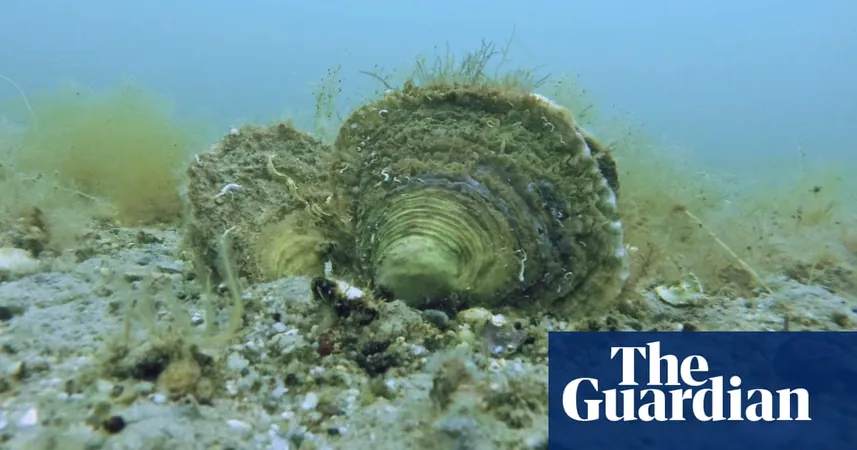
Once Vast and Vibrant: The Tragic Decline of Europe's Oyster Reefs
2024-10-03
Author: Yu
Introduction
Europe’s once-bustling oyster reefs, which once spanned an area greater than Northern Ireland, now exist only as mere remnants along the continent’s coasts. A new study, spearheaded by British scientists, reveals the shocking extent of these natural habitats, which have been devastated by centuries of overfishing, habitat destruction through dredging, and relentless pollution.
Research Findings
The findings come from extensive research involving dozens of experts who meticulously combed through a wide variety of historical records—including government documents, nautical charts, fishery reports, accounts from naturalists, and newspapers spanning the 18th to early 20th centuries. The study details that these expansive reefs, formed by the European flat oyster (Ostrea edulis), once covered a staggering 1.7 million hectares (4.2 million acres) from Norway down to the Mediterranean.
Current State of Oyster Reefs
Researchers uncovered poignant records that described sprawling oyster reefs at 1,196 sites across several European countries, including the UK, France, Ireland, Denmark, Spain, Germany, and the Netherlands. Strikingly, one scientific article even recounted reefs in the Black Sea that reached heights of up to seven meters.
Ruth Thurstan from the University of Exeter, the report's joint lead author, expressed her astonishment: "While I knew that oysters used to be harvested in immense quantities, the sheer coverage of these reefs is nothing short of amazing." Today, however, sightings of the flat oyster have become increasingly rare in UK waters. “The reefs that once thrived have vanished, leaving behind a flat and muddy seafloor,” added Thurstan.
Ecological Importance of Oyster Reefs
These reefs served as crucial ecosystems, hosting nearly 200 fish and crustacean species, including the common stingray, the short-snouted seahorse, and the European sturgeon. They also played integral roles in stabilizing coastal shorelines, cycling nutrients, and filtering water. Sadly, most of these important ecological functions have been lost due to the destruction of the reefs.
Remnant Oyster Reefs
Currently, a handful of remnant reefs can still be found along the coasts of Brittany and the western shores of Ireland and Scotland, but these are no larger than a few square meters—pale shadows of their former selves. “We refer to these areas as functionally extinct,” stated Thurstan, as the ecological services they used to provide are now absent.
Historical Accounts
Accounts of the recent past evoke profound sorrow as they chronicle what has been irretrievably lost. A writer in 1852 noted the vast oyster beds of the Wash, reporting that “one bed extended nearly the entire length of the Wash for about 50 miles,” emphasizing the sheer abundance that once flourished. Another vividly described how it took twenty boats seven years to dredge oysters from a reef off the Isle of Man, with one vessel retrieving 30,000 oysters in just a week.
In 1909, one report detailed the dramatic scale of oyster fishing in France: “During a span of just two weeks in April, 16 million oysters were caught.”
Restoration Efforts and Urgency
While some oyster restoration projects are currently underway, experts argue that these efforts need to be significantly expanded. Philine zu Ermgassen, an honorary researcher at the University of Edinburgh, highlighted the urgency of the situation, stating, “The destruction of these slow-forming reefs occurred at an alarming pace, leading to a fundamental reshaping of our seafloors, which now lack the rich biodiversity they once held.”
Conclusion
As Europe grapples with the aftermath of its oyster reef catastrophe, there is a growing call for heightened conservation measures and restoration initiatives to revive these vital marine ecosystems before they vanish forever.


 Brasil (PT)
Brasil (PT)
 Canada (EN)
Canada (EN)
 Chile (ES)
Chile (ES)
 España (ES)
España (ES)
 France (FR)
France (FR)
 Hong Kong (EN)
Hong Kong (EN)
 Italia (IT)
Italia (IT)
 日本 (JA)
日本 (JA)
 Magyarország (HU)
Magyarország (HU)
 Norge (NO)
Norge (NO)
 Polska (PL)
Polska (PL)
 Schweiz (DE)
Schweiz (DE)
 Singapore (EN)
Singapore (EN)
 Sverige (SV)
Sverige (SV)
 Suomi (FI)
Suomi (FI)
 Türkiye (TR)
Türkiye (TR)